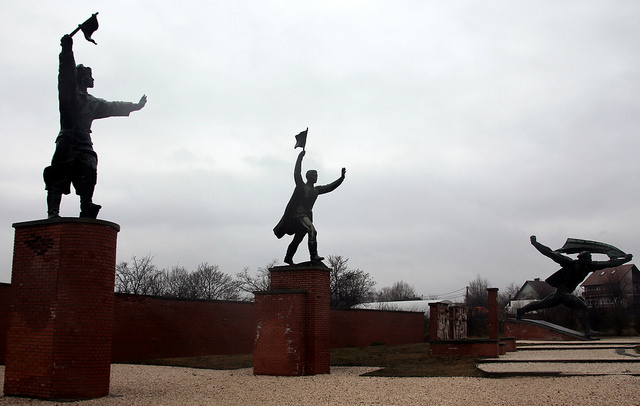
Visible and Invisible History in Budapest
A muscular arm, outstretched; a clenched fist trailing a ragged flag into an arc over head and shoulders. A friend’s comment that the statue is not “artful” (whatever that means) is disputed by an onlooker, possibly one of the ‘communist nostalgia tourists’. My guidebook comments: “It is beautiful. It shows that if we stand together, we can achieve anything. We can achieve the world.” Interpretations of “we” now line the pathways in statue form: the idealised masses, encapsulations of physical might and subservience, their metal faces set in looks of fierce determination. Among them stand deified incarnations of Lenin and Marx, disrupting the uniformity of the collective.
We are standing in Memento Park just outside Budapest. The peeling facades, doorways, and spires of the city’s imperial centre delineate almost every period of its history, yet Memento Park is an exception. Here are the remnants of Hungary’s communist regime, exiled to the suburbs. For me, it is impossible to walk around the park without drawing comparisons with the Rhodes Must Fall controversy. Budapest’s propaganda scrapyard evokes not only the inherently political nature of monuments, but also that a statue can be at least as sinister an attempt to simplify the past and present as the removal of one.
Back in central Budapest, the bold, discordant cacophony of iconography makes me realise that the urge to scrub the city, with its visible history of perceived imperfections, isn’t confined to Memento Park. Gellért Hill, a craggy hunk of land jutting upwards from the Buda skyline, commemorates an eleventh-century missionary on a Vatican-issued mandate for mass conversion; he overlooks the heathen city, arms outstretched. Atop this sits the Liberty Monument, commissioned by Miklós Horthy, the inter-war fascist general who saw Budapest as intolerably left-wing and Jewish. After the war, the Liberty monument became a symbol of Soviet power, flanked by hard-eyed ‘liberation soldiers’ who now guard Memento Park. Many of the Russian soldiers these statues represent have since been implicated in horrors committed during the 1945 siege. Now, in the corner of Liberty Square, a statue of Ronald Reagan seems to be striding into open space. The traumatic and irrecoverably complex realities of history are shielded from view by stony faces. It is the kind of simplification feared and decried by both Rhodes Must Fall Oxford and its critics.
Outside Memento Park stand Stalin’s boots. Planted on a brick pedestal, their size leads you to envisage the form of the complete statue in Heroes’ Square, where it held its place until 1956. The rest of the statue was destroyed that November as a twelve-day uprising swept the capital: a burst of anti-totalitarian fervour crushed when Moscow sent in the tanks and killed over two thousand people. Like Stalin’s body, these events now exist only in the realm of historical imagination. The onward progression of history is expressed through the rush of people around a monument as it falls, through the refusal to let symbols define a living city or to let statues of leaders eclipse those gathered below.
Once more, I am reminded of ‘we’ the people: this time as the real crowds heaving past ‘heroic’ versions of themselves every day. Now they are gone, along with much of the city they would have recognised: to this day, the streets of Budapest are marked by bomb damage from wars, uprisings, and reprisals. Buildings are interspersed with open spaces where others should be: tears in a tapestry. Absent structures cannot flank city streets and absent crowds are unable to flock around trams or start revolutions. As the monuments of Memento Park make clear, in the writing of Budapest’s history onto the mind as well as onto the visible city, presence is not essential.
Photo: Simon Lee






